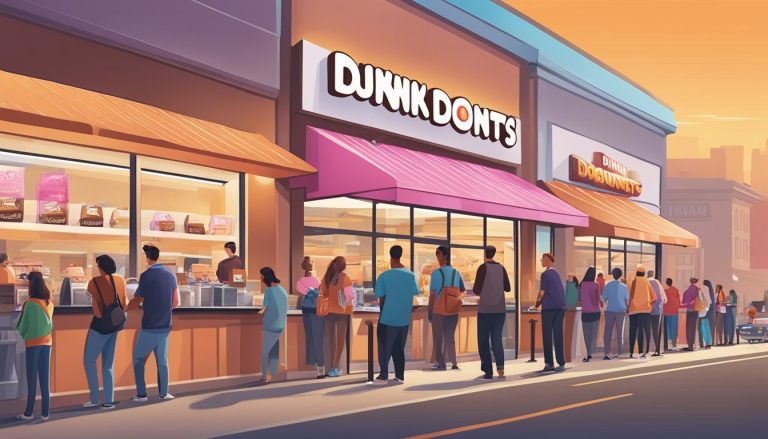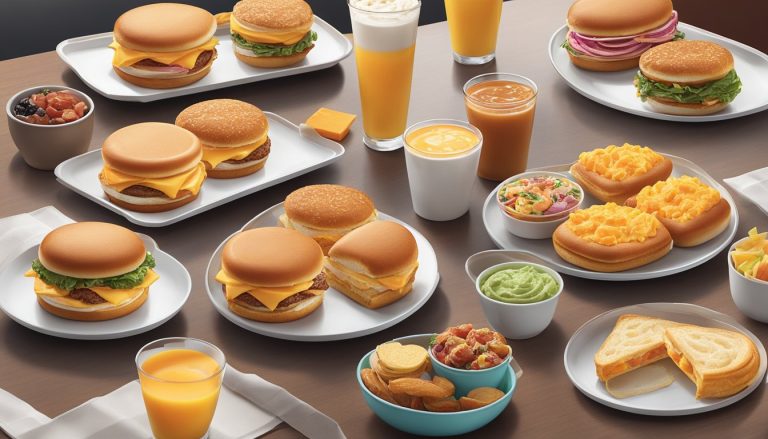Dunkin’, formerly known as Dunkin’ Donuts, has long been a staple in the American breakfast landscape. The company’s commitment to innovation and meeting consumer needs has driven its breakfast menu development process over the years. Dunkin’s menu R&D team, led by executive chefs and innovation experts, carefully analyzes breakfast trends and customer preferences to create new offerings that resonate with their target audience.
The brand’s evolution from a donut-centric establishment to a beverage-focused powerhouse has been strategic and deliberate. Dunkin’ has expanded its menu to include a wide range of breakfast items, from Wake-Up Wraps to heartier sandwiches like the Big N’ Toasty. This diversification reflects the company’s understanding of changing consumer habits and their desire for convenient, on-the-go breakfast options.
Dunkin’s breakfast menu development also aligns with its brand promise of “America Runs on Dunkin’.” By continuously refining and expanding their morning offerings, Dunkin’ aims to energize and delight customers with quality, speed, and convenience. This approach has helped Dunkin’ maintain its position as a leading breakfast destination in a competitive fast-food market.
History and Brand Evolution
Dunkin’ has transformed from a small doughnut shop to a global beverage and baked goods powerhouse. The company’s journey spans decades of growth, rebranding efforts, and international expansion.
Founding and Franchise Growth
William Rosenberg opened the first Dunkin’ Donuts in Quincy, Massachusetts in 1950. The shop quickly gained popularity for its coffee and doughnuts. By 1955, Rosenberg began franchising the Dunkin’ Donuts concept.
The franchise model proved successful, allowing rapid expansion across the United States. In the 1960s and 1970s, Dunkin’ Donuts became a household name in many parts of the country.
The menu expanded beyond doughnuts to include muffins, bagels, and breakfast sandwiches. This diversification helped Dunkin’ appeal to a broader customer base and compete in the growing fast-food breakfast market.
Rebranding and ‘America Runs on Dunkin’
In 2006, Dunkin’ launched its iconic “America Runs on Dunkin'” slogan. This campaign solidified the brand’s identity as a go-to spot for coffee and quick breakfast options.
The company underwent a significant rebranding in 2019, dropping “Donuts” from its name to become simply “Dunkin'”. This change reflected the brand’s evolution beyond doughnuts and its increased focus on beverages.
The new logo and branding aimed to portray Dunkin’ as a more versatile and modern brand. Despite the name change, the company maintained its recognizable pink and orange color scheme.
Global Expansion and Market Presence
Dunkin’ began its international expansion in the 1970s. The brand now operates in over 40 countries, adapting its menu to local tastes and preferences.
In many international markets, Dunkin’ competes with local coffee shops and global chains like Starbucks. The company has found success by offering a mix of familiar products and region-specific items.
Dunkin’ has also expanded through strategic partnerships and acquisitions. In 1990, the company was acquired by Allied-Lyons, which later became Allied Domecq. In 2006, Dunkin’ Brands was sold to a consortium of private equity firms before going public in 2011.
Conceptualizing the Breakfast Menu

Dunkin’ approaches breakfast menu development through a strategic process focused on consumer needs, market trends, and nutritional considerations. This multi-faceted approach aims to create appealing and competitive offerings.
Understanding Consumer Preferences
Dunkin’ conducts extensive consumer research to identify key breakfast preferences. Surveys and focus groups provide insights into taste preferences, portion sizes, and desired menu variety. The company analyzes purchase data to track popular items and emerging trends.
Convenience is a top priority for many Dunkin’ customers. This has led to the development of portable options like Wake-Up Wraps and breakfast sandwiches. The chain also caters to different dietary needs, offering choices like the Power Breakfast Sandwich for protein-seekers.
Flavor profiles are carefully tested to ensure broad appeal. Dunkin’ balances classic breakfast tastes with innovative combinations to keep the menu fresh and exciting.
Market Analysis and Competitor Benchmarking
Dunkin’ closely monitors competitor offerings and industry trends. The company analyzes menus, pricing, and marketing strategies of other quick-service restaurants and coffee chains. This helps identify gaps in the market and opportunities for differentiation.
Price point analysis ensures Dunkin’s breakfast items remain competitive while maintaining profitability. The chain aims to offer value through combo meals and promotional deals.
Innovation is key to staying ahead. Dunkin’ regularly introduces limited-time offers to gauge customer interest in new concepts. Successful items may become permanent menu additions.
Incorporating Nutritional Considerations
Nutritional content plays a crucial role in menu development. Dunkin’ strives to balance taste with health-conscious options. The company works with nutritionists to optimize recipes for calories, fat, protein, and carbohydrates.
Transparency is important. Dunkin’ provides detailed nutritional information for all menu items, allowing customers to make informed choices. The chain has introduced several lower-calorie options, such as egg white sandwiches.
Ingredient quality is a focus. Dunkin’ has made efforts to remove artificial dyes and flavors from many products. The company also explores plant-based alternatives to cater to changing dietary preferences.
Product Creation and Testing
Dunkin’s breakfast menu development involves a multifaceted approach combining culinary innovation, customer feedback, and real-world testing. This process ensures new products meet quality standards and customer expectations.
Culinary Innovation and Recipe Development
Dunkin’s culinary team focuses on creating unique flavor combinations and enhancing product quality. They experiment with ingredients and cooking methods to develop new breakfast items. The team aims to balance familiar flavors with innovative twists, catering to changing consumer preferences.
Chefs work on perfecting recipes for items like omelets and bakery sandwiches. They consider factors such as taste, texture, and portability. The goal is to create products that align with Dunkin’s brand while offering exciting new options for customers.
Focus Groups and Customer Feedback
Customer input plays a crucial role in Dunkin’s product development. The company organizes focus groups to gather opinions on potential new menu items. Participants taste prototypes and provide feedback on flavors, textures, and overall appeal.
Dunkin also collects customer feedback through surveys and social media. This information helps identify trends and preferences. The company uses this data to refine recipes and prioritize which products to bring to market.
Pilot Programs and Market Trials
Before full-scale launches, Dunkin tests new products in select markets. These pilot programs allow the company to assess real-world performance and customer reception. Test locations offer the new items for a limited time, tracking sales and gathering customer reactions.
During these trials, Dunkin evaluates factors such as operational feasibility and supply chain logistics. The company also monitors how new products integrate with existing menu offerings. Successful items from these trials may then roll out to more locations or receive further refinement based on the results.
Menu Introduction and Promotion
Dunkin’ employs a multi-faceted approach to introduce and promote new breakfast menu items. The company leverages various channels and strategies to generate excitement and drive customer engagement.
Advertising and Marketing Strategies
Dunkin’ utilizes a mix of traditional and digital advertising to promote new menu offerings. Television commercials showcase the latest breakfast items, highlighting their flavors and convenience. Social media campaigns create buzz through eye-catching visuals and interactive content.
The brand often partners with influencers to reach younger demographics. These collaborations feature influencers sampling new products and sharing their experiences. Dunkin’ also employs targeted email marketing to inform loyal customers about menu updates and special promotions.
Seasonal campaigns tie new menu items to holidays or events, creating a sense of urgency and relevance.
Strategic Partnerships and Co-branding
Dunkin’ forms strategic alliances to expand its reach and appeal. Collaborations with popular brands result in limited-time offerings that generate excitement. These partnerships often blend Dunkin’s breakfast expertise with another brand’s signature flavors or products.
Co-branded items are promoted through joint marketing efforts, leveraging both companies’ customer bases. Dunkin’ has partnered with cereal brands to create donut flavors inspired by beloved breakfast cereals.
The company also aligns with sports teams and events, creating themed menu items and promotions that resonate with fans.
In-store and Digital Rollout
New menu items are prominently displayed in-store through vibrant signage and menu board updates. Staff receive training on new offerings to effectively communicate their features and benefits to customers.
Dunkin’s mobile app plays a crucial role in digital rollout. Push notifications alert users to new items, while in-app promotions encourage trial. The app’s order-ahead feature allows customers to easily add new items to their regular orders.
Digital menu boards in drive-thrus showcase new offerings with dynamic content. Dunkin’ also utilizes geotargeted ads to promote location-specific menu introductions and limited-time offers.
Technological Integration
Dunkin’ has embraced digital solutions to enhance customer experience and streamline operations. These innovations focus on loyalty programs and service delivery improvements.
Leveraging DD Perks for Customer Loyalty
DD Perks, Dunkin’s loyalty program, uses technology to reward frequent customers. Members earn points on purchases, redeemable for free beverages. The program offers personalized offers based on individual preferences and purchase history.
Mobile app integration allows easy point tracking and reward redemption. Push notifications alert customers to special promotions and new menu items. This digital approach fosters customer engagement and encourages repeat visits.
DD Perks also collects valuable data on customer behavior. Dunkin’ uses this information to refine menu offerings and tailor marketing strategies.
Digital Transformation in Service Delivery
Dunkin’ has implemented digital ordering solutions to improve service speed and accuracy. Mobile ordering allows customers to place orders in advance, reducing wait times.
In-store kiosks provide a self-service option, particularly useful during peak hours. These touchscreens offer a visual menu and customization options, enhancing order accuracy.
Digital menu boards display dynamic content, easily updated for promotions or new items. This technology allows for quick menu changes and improves visual appeal.
Behind the scenes, kitchen display systems streamline order processing. These systems improve communication between front-of-house and kitchen staff, leading to faster service.
Continuous Growth and Adaptation

Dunkin’ has demonstrated a commitment to evolving its breakfast menu to meet changing consumer preferences and market trends. The company focuses on expanding product lines while adapting to emerging dietary needs and food trends.
Expanding Product Lines
Dunkin’ regularly introduces new items to its core menu to keep customers engaged. The QSR chain has added healthier options like egg white omelets to appeal to health-conscious diners. Dunkin’ also experiments with plant-based alternatives, such as the Beyond Sausage breakfast sandwich, catering to vegetarian and flexitarian eaters.
New seasonal and limited-time offerings help drive customer excitement and repeat visits. These include unique coffee flavors and creative donut varieties that change throughout the year.
Adapting to Emerging Trends and Diets
Dunkin’ closely monitors food trends and dietary preferences to stay relevant. The company has increased its selection of gluten-free and dairy-free options to accommodate customers with dietary restrictions.
Nutritional transparency has become a priority, with calorie counts displayed on menu boards. Dunkin’ has also reduced artificial ingredients in many products to appeal to ingredient-conscious consumers.
By balancing innovation with familiar favorites, Dunkin’ aims to maintain its loyal customer base while attracting new patrons. This adaptive approach helps the chain remain competitive in the fast-evolving QSR breakfast segment.
Operational Excellence in Execution

Dunkin’ has honed its operational processes to deliver consistently high-quality products with speed and efficiency. The company’s focus on streamlined kitchen operations and optimized supply chain management enables it to meet customer demands effectively.
Streamlining Kitchen Operations
Dunkin’ employs a highly efficient kitchen layout designed for rapid order fulfillment. Strategically placed equipment and workstations minimize employee movement, reducing preparation time. The company uses standardized recipes and portion control tools to ensure consistency across locations.
Automated brewing systems maintain coffee quality while freeing staff to focus on other tasks. Digital order displays and kitchen management systems help coordinate production and prevent bottlenecks. Regular staff training programs emphasize speed and accuracy in food preparation.
Dunkin’ also utilizes self-service kiosks in many locations, allowing customers to place orders directly with the kitchen. This technology reduces wait times and improves order accuracy.
Optimizing Supply Chain and Logistics
Dunkin’ has developed a robust supply chain network to support its extensive operations. The company partners with reliable suppliers to ensure a steady flow of fresh ingredients to its stores. Centralized distribution centers strategically located near clusters of restaurants minimize transportation costs and delivery times.
Advanced inventory management systems track stock levels in real-time, triggering automated reorders to prevent shortages. Dunkin’ utilizes data analytics to forecast demand, helping stores maintain optimal inventory levels and reduce waste.
The company’s logistics operations are designed for efficiency, with carefully planned delivery routes and schedules. This ensures that each store receives frequent deliveries of fresh products while minimizing transportation costs.
Ensuring Sustainable Practices

Dunkin’ has implemented several initiatives to enhance sustainability in its breakfast menu development process. These efforts focus on responsible sourcing and minimizing waste throughout the supply chain.
Source Responsibly
Dunkin’ has committed to sourcing 100% responsibly sourced coffee by 2025 through its Drive-To Sustainability Program. This initiative aims to support coffee farmers and protect the environment. The company is also transitioning to cage-free eggs for its U.S. menu items.
By the end of 2016, 10% of eggs used in breakfast sandwiches were cage-free. Dunkin’ plans to complete the transition to 100% cage-free eggs by December 31, 2025.
For pork products, Dunkin’ has pledged to use only gestation crate-free pork in the U.S. by 2022. These changes reflect the company’s dedication to animal welfare and sustainable farming practices.
Waste Reduction Initiatives
Dunkin’ is actively working to reduce waste in its restaurants and supply chain. The company has implemented recycling programs for packaging materials and coffee grounds.
Dunkin’ is exploring innovative packaging solutions to minimize environmental impact. They are testing compostable and recyclable materials for cups, lids, and other food containers.
The brand is also focusing on energy efficiency in its restaurants. This includes installing LED lighting and energy-efficient equipment to reduce electricity consumption.
Dunkin’ encourages customers to bring reusable cups for their beverages, offering small discounts as an incentive. This initiative helps decrease single-use cup waste and promotes sustainable consumer behavior.
Future Outlook

Dunkin’ is poised for significant growth and innovation in its breakfast menu offerings. The company plans to leverage consumer trends and expand its global presence while staying true to its core breakfast and beverage focus.
Upcoming Innovations in the Breakfast Category
Dunkin’ is set to introduce new health-conscious breakfast options to cater to evolving consumer preferences. Plant-based protein alternatives and low-carb wraps are likely to appear on menus soon. The chain is also exploring innovative breakfast sandwiches featuring unique flavor combinations and artisanal ingredients.
Beverage innovation remains a key focus. Expect to see more cold brew variations, functional beverages with added health benefits, and customizable drink options. Dunkin’ may introduce seasonal limited-time offerings to generate excitement and drive foot traffic.
Technology integration will play a crucial role in enhancing the breakfast experience. Mobile ordering improvements and AI-powered personalized recommendations are on the horizon.
Long-term Brand Initiatives
Global expansion is a major part of Dunkin’s long-term strategy. The company aims to increase its presence in emerging markets, adapting its breakfast menu to local tastes and preferences.
Sustainability efforts will shape future product development. Dunkin’ is likely to focus on sourcing more environmentally friendly ingredients and reducing packaging waste. This aligns with growing consumer demand for eco-conscious options.
Digital transformation will continue to be a priority. Enhanced loyalty programs, data-driven menu optimization, and seamless omnichannel experiences are expected to drive customer engagement and sales growth.
Dunkin’ may explore partnerships with other brands or celebrities to create buzz and attract new customer segments. These collaborations could result in unique breakfast items or themed promotions.




